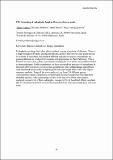Por favor, use este identificador para citar o enlazar a este item:
http://hdl.handle.net/10261/166000COMPARTIR / EXPORTAR:
 SHARE
BASE SHARE
BASE
|
|
| Visualizar otros formatos: MARC | Dublin Core | RDF | ORE | MODS | METS | DIDL | DATACITE | |

| Campo DC | Valor | Lengua/Idioma |
|---|---|---|
| dc.contributor.author | Velasco Pazos, Pablo | es_ES |
| dc.contributor.author | Abilleira Ambroa, Rosaura | es_ES |
| dc.contributor.author | Ramos Delgado, María | es_ES |
| dc.contributor.author | Zabalgogeazcoa, Iñigo | es_ES |
| dc.date.accessioned | 2018-06-08T12:13:56Z | - |
| dc.date.available | 2018-06-08T12:13:56Z | - |
| dc.date.issued | 2017-05 | - |
| dc.identifier.citation | Abstracts Book of the 7th International Symposium on Brassicas: 57 (2017) | es_ES |
| dc.identifier.uri | http://hdl.handle.net/10261/166000 | - |
| dc.description | 1 página.- Resumen del póster presentado en el Simposio organizado por la Misión Biológica de Galicia (MBG-CSIC) y la International Society of Horticultural Science (ISHS) en Pontevedra, entre el 22 y el 25 de mayo de 2017. | es_ES |
| dc.description.abstract | Endophytes are fungi that infect plants without causing symptoms of diseases. There is a large biological diversity among endophytes, and it is not rare for some plant species to be hosts of more than one hundred different endophytic species. Endophytes are gaining attention as a subject for research and applications in Plant Pathology. This is because in some cases, plants associated to endophytes have shown increased resistance to plant pathogens. In this experiment, we have screened the presence of endophytes in the roots of five Brassica oleracea local populations. The isolated fungal endophytes were identified based on the morphological traits and fungal ITS1-5.8S-ITS4 region sequence analysis. From all the roots analyzed, we found 24 different genera. Acrocalymma vagum, Setophoma terrestris and Fusarium oxysporum were the most abundant species, with a percentage of 24%, 22% and 13% of the total samples analyzed, respectively. Other endophytes, recognized by its beneficial effects on plants like Trichoderma hamatum or Penicillium janthinellum, were also found in B. oleracea roots. | es_ES |
| dc.language.iso | eng | es_ES |
| dc.publisher | CSIC - Misión Biológica de Galicia (MBG) | es_ES |
| dc.relation.isversionof | Publisher's version | es_ES |
| dc.rights | openAccess | es_ES |
| dc.subject | Brassicas | es_ES |
| dc.subject | Endophytic | es_ES |
| dc.subject | Fungus | es_ES |
| dc.subject | Mutualism | es_ES |
| dc.title | Screening of endophytic fungi in Brassica oleracea roots | es_ES |
| dc.type | comunicación de congreso | es_ES |
| dc.description.peerreviewed | Peer reviewed | es_ES |
| dc.relation.csic | Sí | es_ES |
| oprm.item.hasRevision | no ko 0 false | * |
| dc.type.coar | http://purl.org/coar/resource_type/c_5794 | es_ES |
| item.openairetype | comunicación de congreso | - |
| item.grantfulltext | open | - |
| item.cerifentitytype | Publications | - |
| item.openairecristype | http://purl.org/coar/resource_type/c_18cf | - |
| item.fulltext | With Fulltext | - |
| item.languageiso639-1 | en | - |
| Aparece en las colecciones: | (MBG) Comunicaciones congresos | |
Ficheros en este ítem:
| Fichero | Descripción | Tamaño | Formato | |
|---|---|---|---|---|
| Velasco_Screening_endophytic...pdf | 192,29 kB | Adobe PDF |  Visualizar/Abrir |
CORE Recommender
Page view(s)
382
checked on 19-abr-2024
Download(s)
105
checked on 19-abr-2024
Google ScholarTM
Check
NOTA: Los ítems de Digital.CSIC están protegidos por copyright, con todos los derechos reservados, a menos que se indique lo contrario.
